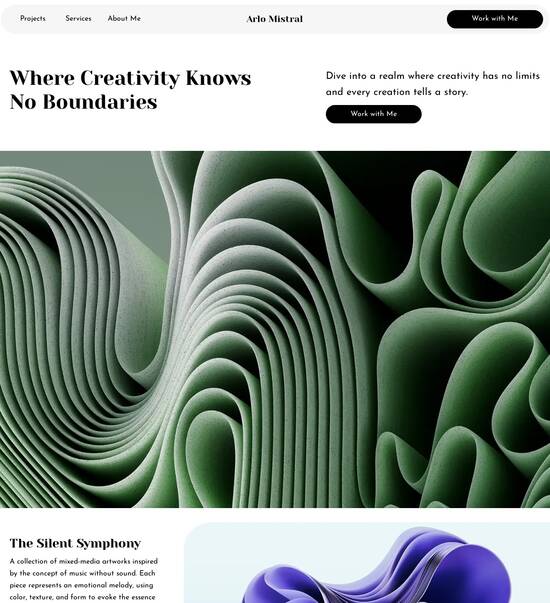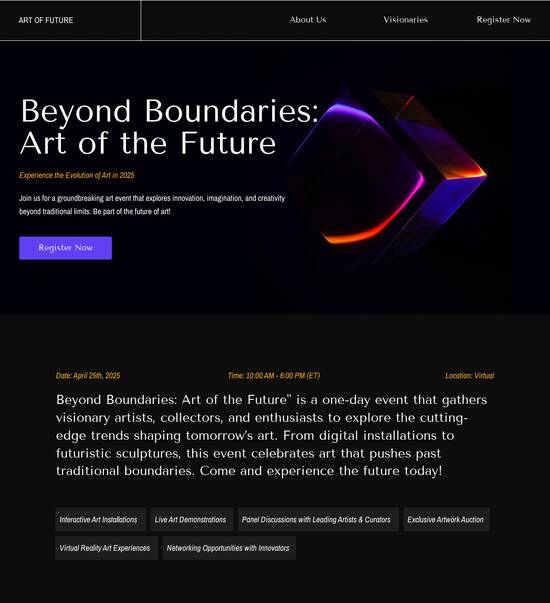
Coming soon page template for Node.js developers
Explore Similar TemplatesAbout template
Master your online marketing with this builder for coming soon page template for Node.js developers. Try more tools to create an immaculate landing page.
Recommended templates

Easy to build without coding
With the intuitive drag-and-drop builder, anyone on your team can create high-converting pages without any knowledge of code or design. Make enhancements to your landing page with custom widgets using Javascript, HTML/CSS, or third-party scripts.

Multiple layouts for any industry and goal
Select from 500+ landing page layouts built to boost conversions across industry-specific scenarios. Customize them by adjusting fonts, adding images, and generating on-brand content with the AI assistant. Quickly scale with Instablocks® and Global Blocks that you can save, reuse, and update globally.

Loads fast and looks polished on any device
Every template is responsive, which means they present professionally on any device and load blazingly fast with our Thor Render Engine. You can also power them up with Google AMP technology to deliver an unparalleled mobile experience and drive higher conversions.

Robust analytics & experimentation
Get real-time updates and reporting across all your devices, showing the number of visitors, conversions, cost-per-visitor, and cost-per-lead. Launch AI-powered experiments, run A/B tests, and use heatmaps to analyze user behavior, then optimize your landing page to maximize conversions.







Easy to build without coding
With the intuitive drag-and-drop builder, anyone on your team can create high-converting pages without any knowledge of code or design. Make enhancements to your landing page with custom widgets using Javascript, HTML/CSS, or third-party scripts.
Multiple layouts for any industry and goal
Select from 500+ landing page layouts built to boost conversions across industry-specific scenarios. Customize them by adjusting fonts, adding images, and generating on-brand content with the AI assistant. Quickly scale with Instablocks® and Global Blocks that you can save, reuse, and update globally.
Loads fast and looks polished on any device
Every template is responsive, which means they present professionally on any device and load blazingly fast with our Thor Render Engine.
Robust analytics & experimentation
Get real-time updates and reporting across all your devices, showing the number of visitors, conversions, cost-per-visitor, and cost-per-lead. Launch AI-powered experiments, run A/B tests, and use heatmaps to analyze user behavior, then optimize your landing page to maximize conversions.
All the features you need to build nodejs development
Explore more featuresLearn how to build node js developers
FAQs
Leading the way in building high-performing landing pages





A step-by-step guide to using Instapage for optimized landing page creation
Launching effective digital marketing campaigns requires powerful tools that enhance conversion rates. Instapage's unique capabilities allow marketers to design high-impact landing pages specifically tailored to diverse audiences. This guide will detail how to effectively leverage the features of Instapage to optimize your marketing strategies.
Understanding the power of Instapage for landing pages
Instapage simplifies the landing page creation process while providing advanced features that cater to all budgets and team sizes. Here are the core advantages:
- Ready-to-use templates: Access a library of over 100 high-converting templates designed for various industries and marketing needs.
- Analytics dashboard: Monitor performance metrics and understand visitor behavior to refine your marketing strategies effectively.
- A/B testing: Experiment with different landing page variations to determine the most effective designs and content.
Step 1: Create your landing page
To commence the journey with Instapage, follow these simple steps to create your landing page:
- Choose a template: Select a conversion-focused template that aligns with your campaign goals.
- Customize your elements: Use the intuitive builder to adjust text, images, and calls to action without any coding required.
- Preview and publish: Ensure everything looks perfect before you go live; use the preview feature for final adjustments.
Step 2: Optimize for conversions
Leveraging Instapage's built-in optimization tools can dramatically enhance conversion rates.
- Utilize heatmaps: Analyze where users click most often on your landing page to improve layout and content placement.
- Conduct A/B tests: Test variations in content, images, and CTAs to see which drives the best results.
- Review analytics regularly: Use the analytics dashboard to keep tabs on performance and make data-driven improvements.
Step 3: Personalize user experiences
Personalization is key to connecting with diverse audiences. Instapage enables you to create tailored content.
- Dynamic text replacement: Modify your landing page copy based on user data for enhanced relevance.
- AdMaps: Align specific ads to unique landing pages for coherence between marketing campaigns.
- Audience-level tracking: Monitor how different audiences interact with your pages and refine your strategies accordingly.
By effectively using Instapage's features, you can elevate your marketing campaigns and achieve superior conversion rates.
Ready to optimize your campaigns? Start using Instapage today and unlock the full potential of your digital marketing efforts.
People also ask about Coming soon page template for Node.js developers
Creating an Effective Coming Soon Page Template for Node.js Developers
Understanding the necessity of a 'coming soon' page for Node.js projects
Launching a new project is an exciting venture, but it's crucial to build anticipation before unveiling your finished product. This is where a 'coming soon' page comes into play. It serves as a valuable tool for generating pre-launch buzz and lets potential users know that something new is on the horizon.
Having a well-designed coming soon page can amplify your marketing efforts and contribute to the success of your launch. By informing visitors about upcoming developments, you can cultivate a community of interested users who are eager to engage with your project once it's live.
Building anticipation: A cohesive and creative page helps set expectations and creates excitement around your brand.
Collecting leads: A coming soon page is an excellent opportunity to gather email addresses and create a targeted list for future announcements.
Improving SEO: Early visibility on search engines can position your brand favorably and enhance your online presence.
Key features of an effective coming soon page template for Node.js
An effective coming soon page template should prioritize several key features that enhance both aesthetics and functionality. As a Node.js developer, ensuring these elements are well-integrated into your design can help you create an impressive and engaging page.
Responsive design is absolutely essential, especially considering the diverse user base accessing websites from different devices. Implementing responsive design practices ensures that your page looks good and functions well on desktops, tablets, and smartphones.
Importance for diverse internet users: A responsive layout increases user retention and creates a seamless browsing experience.
Best CSS practices for mobile-friendly layouts: Utilize CSS Grid and Flexbox to ensure adaptability across screen sizes.
Customization and branding are equally important. Tailoring visual elements to match your brand identity and adding a unique value proposition will help to connect with your audience. A countdown timer is another powerful feature; it adds a sense of urgency and encourages users to revisit your page as the launch date approaches.
Tech-wise, handling time zones with JavaScript can optimize the countdown timer, ensuring all your users are on the same page regarding your launch.
Target audience: Catering to both beginners and professionals
When it comes to creating a coming soon page, it's essential to consider your target audience. This could range from beginners who are just starting with Node.js to seasoned professionals looking for more advanced options. Addressing the needs of both groups ensures wider applicability of your template.
Beginners typically require straightforward setup instructions and a simple tutorial to get started on creating their first coming soon page. Clear documentation and examples will assist them in navigating through Node.js and getting their projects off the ground.
Basic setup instructions: Provide step-by-step guidelines to install Node.js and set up their environment.
Simple tutorial to create a first coming soon page: Offer a basic structure and explain how to modify it with their own content.
On the other hand, professionals may seek advanced features that enhance functionality. This includes utilizing frameworks like Express.js for streamlined routing and server management, as well as integrating APIs for lead capture and analytics.
Technical setup: A step-by-step guide
Getting started with your coming soon page involves a few technical steps. Begin by ensuring that you have Node.js installed on your system. Alongside this, you’ll need some essential packages to create a robust web application.
Node.js installation guidelines: Download and install Node.js from the official website to set up your development environment.
Essential package installations: Utilize npm to install necessary packages such as Express for server creation and Nodemon for automatic server restarts.
Once your environment is set up, the next step is to create the coming soon page itself. Write clean HTML and CSS to establish the page's structure and aesthetic appeal. JavaScript can be added for interactivity, such as forms for lead capture or countdown functionality.
Sample code snippets for HTML and CSS: Provide templates that users can enhance, explaining how to modify the content.
Incorporating JavaScript for interactivity: Demonstrate how to use JavaScript to implement a countdown timer or form validation.
Finally, deployment is crucial. You have multiple options for hosting your Node.js application. Investigate platforms like Heroku and Vercel, which offer tailored services for Node.js applications.
Hosting services comparison: Examine the features, pricing, and ease of use offered by different hosting platforms.
Domain linking steps: Guide users on how to link their custom domain names with their deployed applications.
Diverse coding languages and their role in crafting effective pages
HTML and CSS are foundational elements in web development, and they play a significant role in creating effective coming soon pages. Structuring the page layout using semantic HTML helps establish clarity and accessibility, while CSS handles the aesthetic components.
Incorporating Flexbox and Grid systems in CSS can drastically improve the responsiveness of your design. These tools allow for flexible layouts, ensuring that your coming soon page looks appealing regardless of screen size. This is particularly important for capturing attention on mobile devices.
Structuring the page layout: Use clear, semantic HTML tags to improve accessibility and SEO.
Utilizing Flexbox and Grid for responsive design: Create versatile layouts that adapt to various screen sizes.
JavaScript can enhance user experience significantly. Adding animation effects or interactive elements keeps users engaged while they wait for your official launch. Techniques like AJAX can allow for dynamic content loading, offering visitors a more diverse experience.
Practical tutorials for building a coming soon page
Hands-on projects are a great way for developers to learn and refine their skills. For beginners, beginner-friendly tutorials can break down each component of creating a coming soon page. Providing step-by-step instructions or video tutorials allows them to visualize the development process and apply techniques in practice.
Step-by-step video tutorials for each stage: Create comprehensive guides that cover every step involved in designing a coming soon page.
Project-based learning: Encourage learners to build from scratch, reinforcing the concepts they have learned.
For more advanced developers, exploring techniques such as using Next.js for static site generation can be beneficial. This framework can improve performance and SEO effectiveness, making it a powerful option for a coming soon page. Server-side rendering capabilities boost load times and ensure your site is indexed efficiently.
Leading services and products that complement your coming soon page
Integrating email marketing solutions is critical for capturing and managing leads effectively. Consider utilizing tools like Mailchimp to seamlessly engage with your audience and build excitement for the launch.
Top tools to capture and manage leads: Highlight email marketing platforms that fit different needs and budgets.
Integrating Mailchimp with your Node.js application: Provide examples of how to add lead capture forms and automate email follow-ups.
Analytics tools are also crucial to track user engagement and pre-launch metrics. Setting up Google Analytics on your coming soon page can provide insights into visitor behavior, allowing you to adjust your strategy as needed.
Establishing an engaging user experience
Design is paramount to creating an engaging user experience. Attractive visuals paired with a thoughtful layout can significantly increase user interest. Conducting A/B testing helps identify the most effective designs and messaging, ultimately leading to higher conversion rates.
Importance of A/B testing different designs: Test variations to determine what resonates best with your audience.
Tools for designing and crafting compelling graphics: Use accessible design software to enhance the visual appeal of your page.
To further enhance user experience, incorporating feedback mechanisms is essential. Enabling users to provide input through surveys or feedback forms can refine your messaging and offerings, aligning them with audience expectations.
Selection and implementation of key functionalities
Selecting between static and dynamic content is an important consideration for your coming soon page. Static pages are quicker to load and easier to create, while dynamic content allows for more interactivity, such as real-time updates and custom user experiences.
Pros and cons for different scenarios: Outline when to choose static or dynamic based on your target goals.
Ideal scenarios for using dynamic features: Highlight the situations where dynamic content can enhance user engagement.
Security measures cannot be overlooked. Protecting user data during the pre-launch phase is crucial for building trust and credibility. Implementing security practices will help safeguard sensitive information and ensure compliance with data protection regulations.
Real-world examples and use-cases
Studying successful launches provides insights into effective strategies. Examining unique tactics used by popular companies can inspire your approach to designing a coming soon page, whereas analyzing case studies of failed pages can help you understand pitfalls to avoid.
Highlighting unique strategies of popular companies: Discuss elements that contributed to their successful page launches.
Lessons learned from failed pre-launch pages: Review common mistakes and how to circumvent them.
Interviews with experienced developers can also offer invaluable insights. Talking to industry professionals can reveal innovative approaches to building effective coming soon pages and share their experiences.
Future trends in coming soon pages
As technology evolves, so do the expectations of web users. Emerging technologies, such as AI and machine learning, are poised to enhance user engagement significantly. Implementing personalized experiences or tailored content can set your coming soon page apart.
Keeping an eye on anticipated changes in user experience design will help you stay ahead. Understanding shifting trends can allow you to refine your coming soon strategy continuously, ensuring it remains relevant and effective.
Wrapping up: The transformation journey of your project
In conclusion, creating a coming soon page requires thoughtful consideration of your audience and strategic design elements. By understanding best practices, utilizing relevant technologies, and remaining flexible to user feedback, you can create a compelling entry point for your project's launch.
Remember, experimenting and innovating in your approach is key. The landscape of web development is ever-changing, and those who adapt will ultimately thrive in delivering engaging user experiences.
Ready to skyrocket conversions?
Supercharge your ad campaigns with high-performing landing pages
Get started














